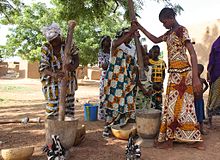African wax prints
African wax prints or wax fabrics are ubiquitous and frequently used clothing fabrics in Africa , especially West Africa . These are industrially manufactured colorful cotton fabrics with a batik print . A distinguishing feature of these fabrics is the lack of a distinction in the color intensity on the front and back. Due to the different manufacturing processes, the wax materials can be divided into different quality categories.
It is commonly assumed that wax materials have a wax coating. However, this is not the case. The name Waxprints is based on the original production process of the textiles. Wax stencils are used to print patterns on already woven fabrics and then to dye them.
Usually the fabrics are sold in 12 yards “full piece” or 6 yards “half piece”. The colors are based on the local preferences of the customers. It is mainly used to make clothes for festive occasions.
To protect the designs, the producer, the product name and the registration number of the design are printed on the selvedge , which also shows the quality of the fabric. There is no precise definition of which substances are considered authentic and inauthentic.
Batik
The Javanese term batik describes a reserve dyeing technique, whereby the dyeing is done with a dye-repellent liquid or paste such as wax, resin or starch. The reserve material is applied, recorded or stamped onto the fabric so that these fabric parts (= pattern ). be protected in the dye bath and after removing the reserve material a light pattern appears.
Manufacturer
Four suppliers of wax materials dominate the market in West Africa:
- Akosombo Textiles Limited (ATL), made in Ghana
- ABC Wax (also known as London Wax ), made by Akosombo Textiles Limited in Ghana
- Vlisco (also known as Dutch Wax ), made in the Netherlands
- Hitarget, production China
history
In the late 16th century, the Dutch brought Javanese batik to Europe and sold it, among other things. a. to the English. Dutch producers started producing the wax materials around 1880. The English factories in Manchester developed their own designs, equipment, colors and techniques for an industrialized version of Indonesian batik fabrics. The sale took place in their colonies in West Africa.
Fancy
The elaborately manufactured wax materials are increasingly imitated by alternative manufacturing processes. These so-called fan fabrics are produced in a printing process. Elaborate designs are made using digital printing.
Fan fabrics are essentially cheap, industrially manufactured imitations of wax fabrics and are based on industrial printing. Fan fabrics are also known as imiwax, Java print, roller print, le fancy or le légos. These fabrics are produced for mass use and stand for short life and impermanence. Fan fabrics are more intense and colorful than wax fabrics and are only printed on one side.
As with the wax fabrics, the producer, the product name and the registration number of the design are printed on the selvedge of the fan fabrics.
The fan fabrics are also subject to a certain fashion. The fabrics are limited in terms of quantity and design and are sometimes sold exclusively in our own shops.
credentials
- ↑ Gabriele Gerlich: Waxprints in the socio-cultural context of Ghana. (PDF, 2.1 MB). Online at: Institute for Ethnology and African Studies, accessed on September 8, 2013, p. 1.
- ↑ African fabrics - development, production and importance of African wax prints
- ^ The complex future of African fabric (which isn't African). Online at: CNN , accessed August 15, 2018.
- ^ The History of Dutch Wax Prints
literature
- G. Gerlich: Wax prints in the socio-cultural context of Ghana. (= Working Paper No. 54). Institute for Ethnology and African Studies. Johannes Gutenberg University Mainz, 2004.
- J. Gillow: African textiles. Color and creativity across a continent. Thames & Hudson, London 2003.
- ML Joseph: Introductory Textile Science. 2nd Edition. Holt, Rinehart and Winston, New York 1972.
- I. Luttmann: The production of fashion: styles and meanings. In: Ilsemargret Luttmann (Hrsg.): Mode in Afrika. Fashion as a means of self-presentation and an expression of modernity. Museum of Ethnology Hamburg. 2005, pp. 33-42.
- J. Picton: Technology, tradition and lurex: The art of textiles in Africa. In: John Picton (Ed.): The art of African textiles. Technology. tradition and lurex. Lund Humphries Publishers, London 1995, pp. 9-32, 132.
- LW Rabine: The global circulation of African fashion. Berg, Oxford 2002.
- KF Schaedler: African Art. From the early days until today. Wilhelm Heyne Verlag, Munich 1997.
- J. Storey: Manual of Textile Printing. Van Nostrand Reinhold Company, New York 1974.
- FB Koné: The dyeing of fabrics in Bamako. In: Bernhard Gardi (Ed.): Boubou c'est chic. Robes from Mali and other West African countries. Museum of Cultures Basel. Christoph Merian Verlag, Basel 2000, pp. 164–171.


